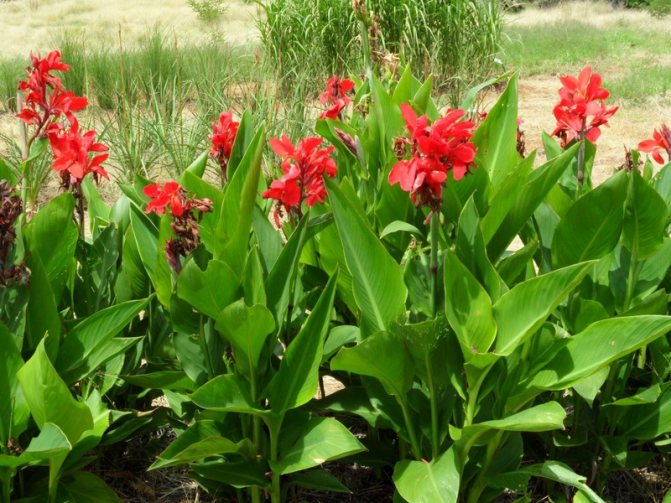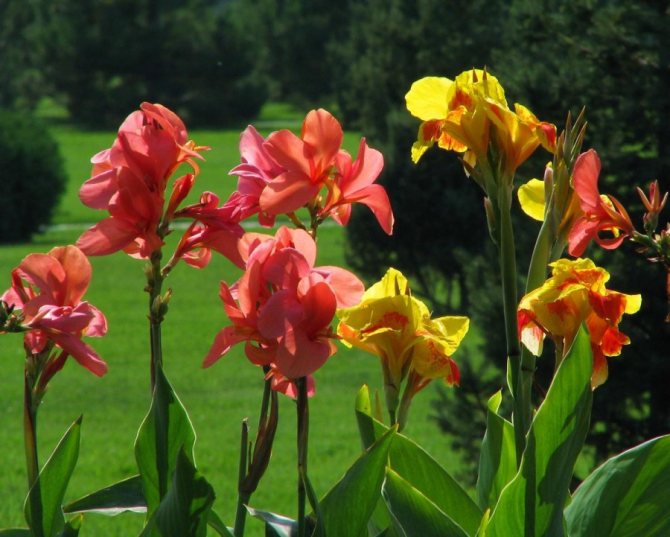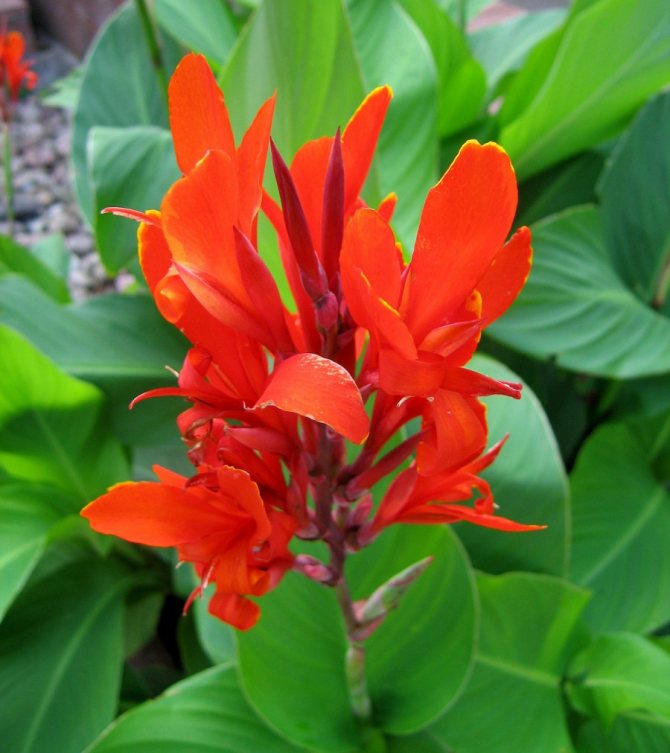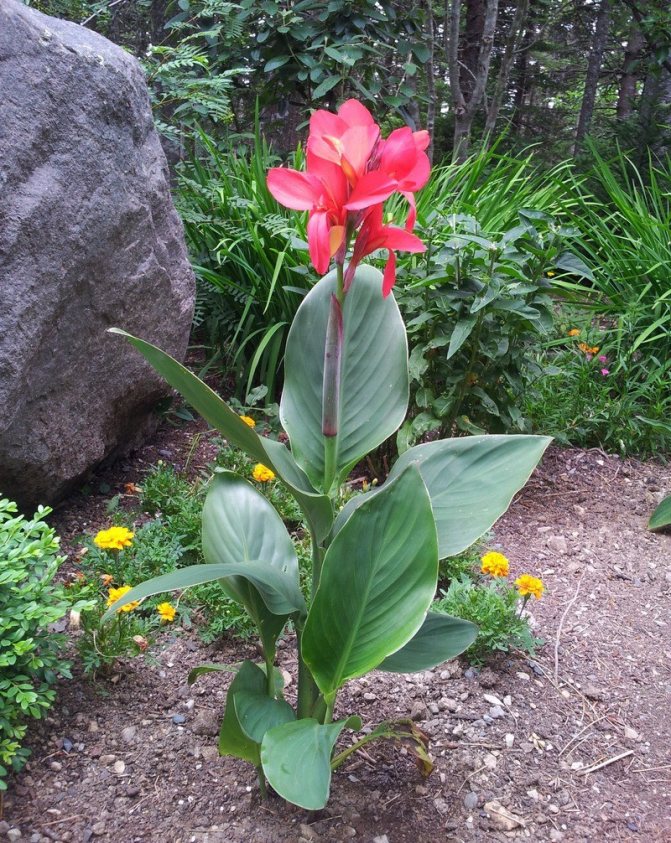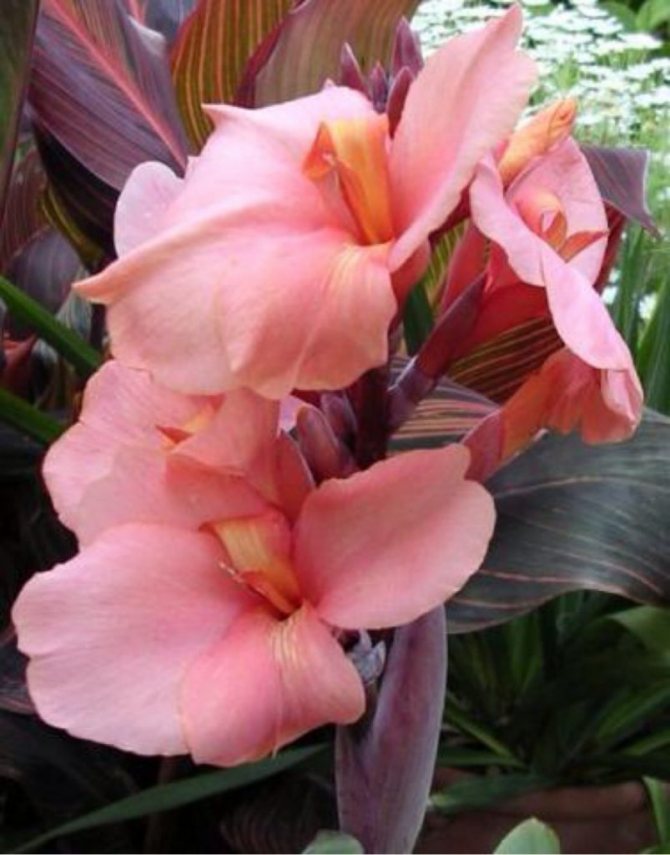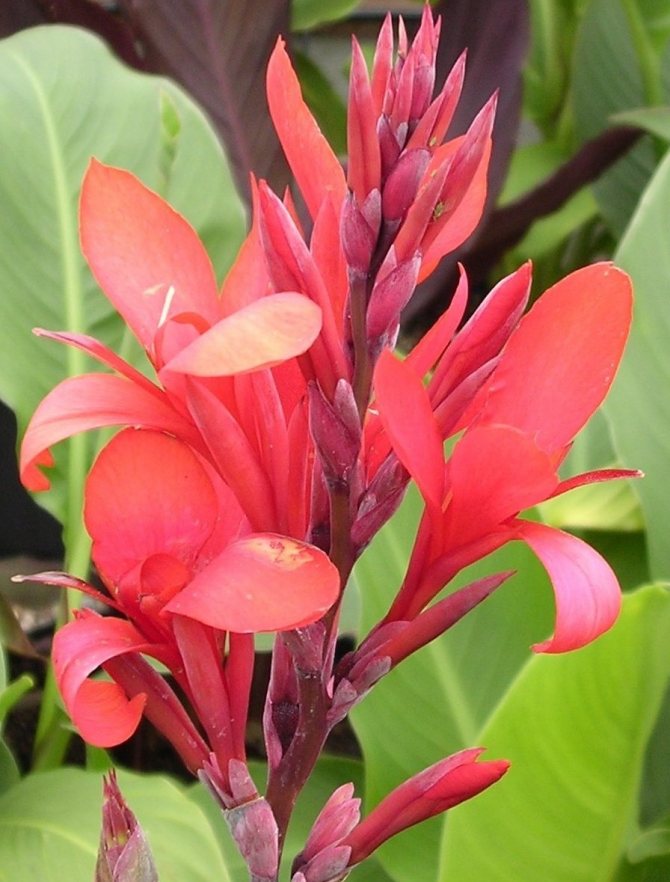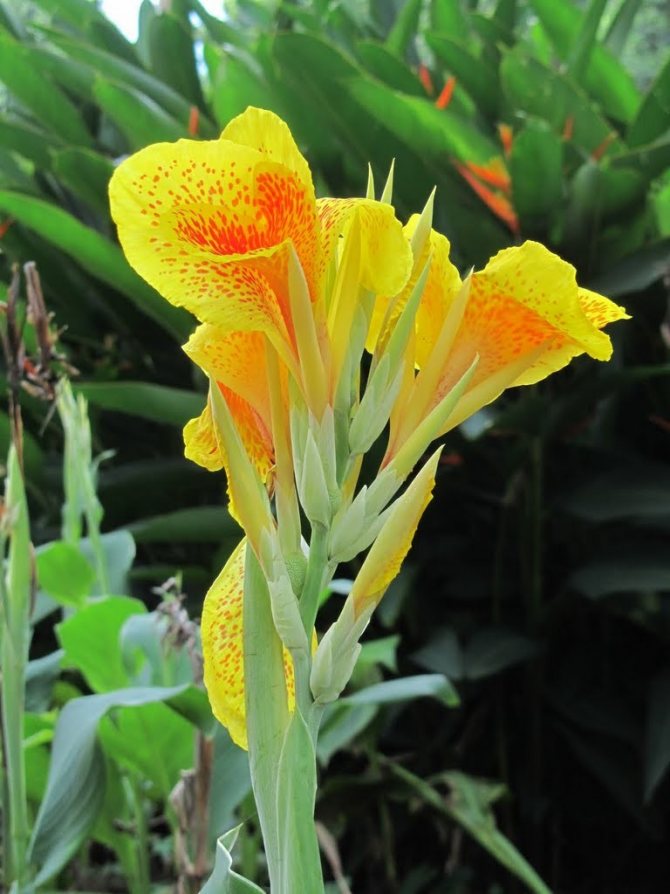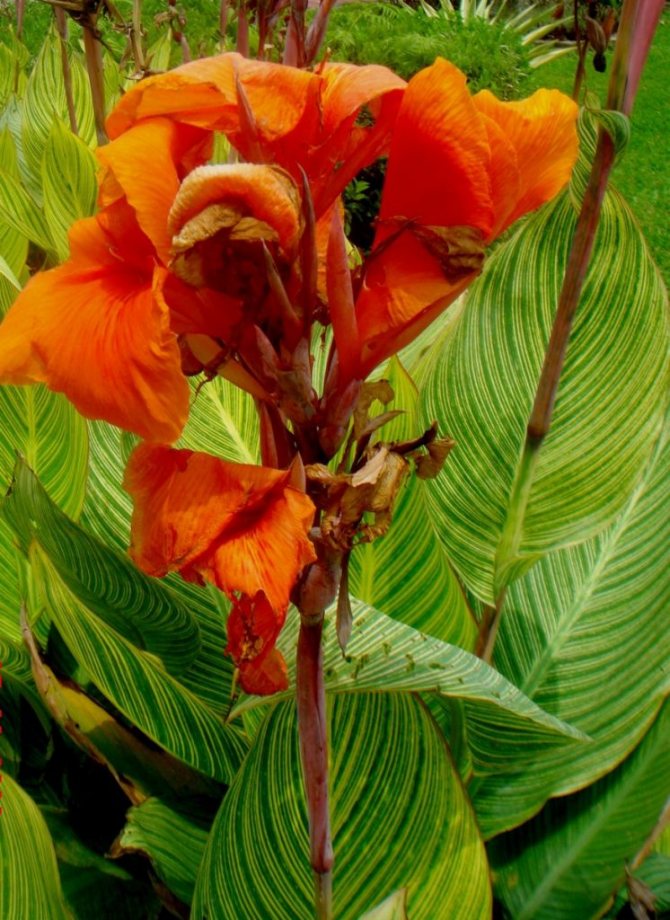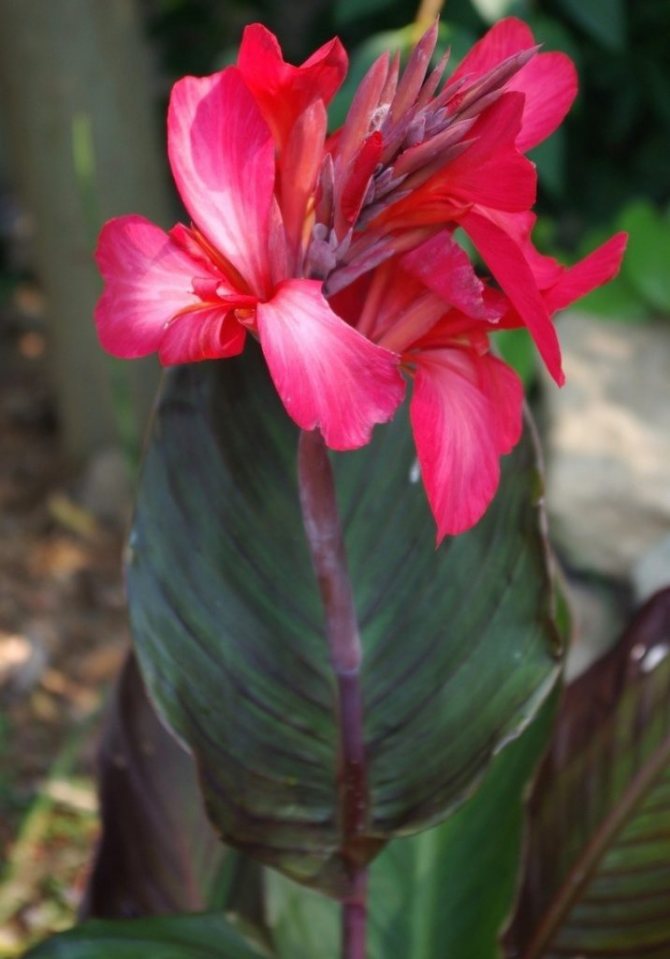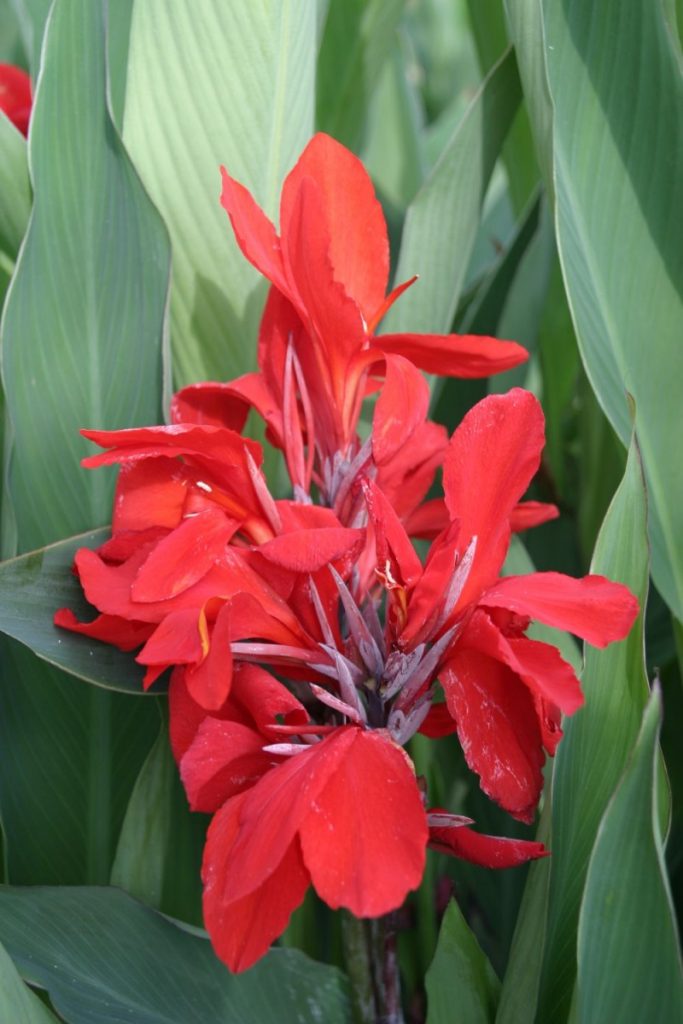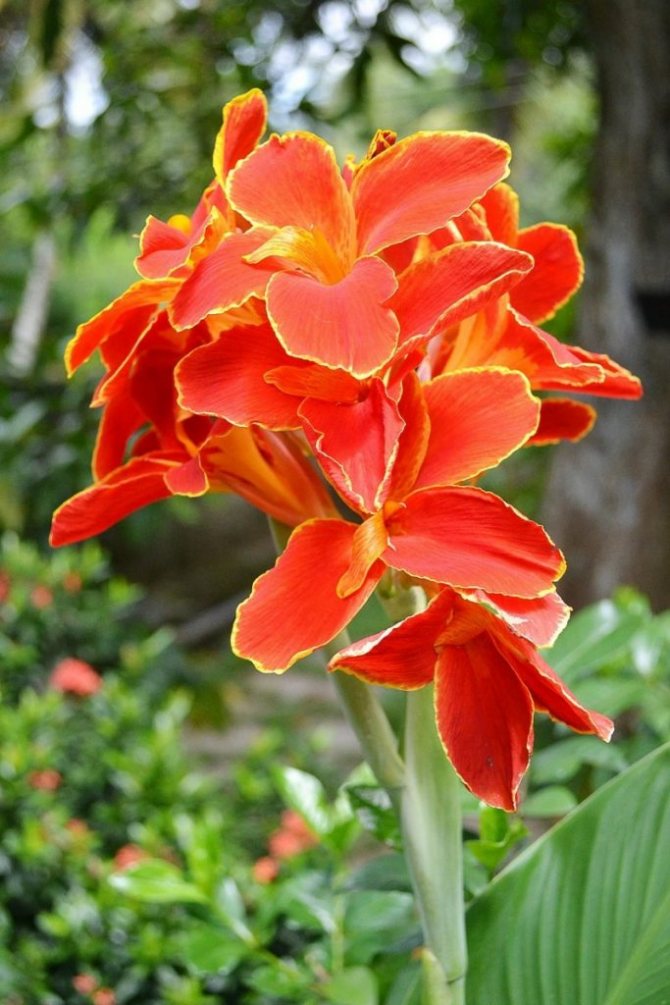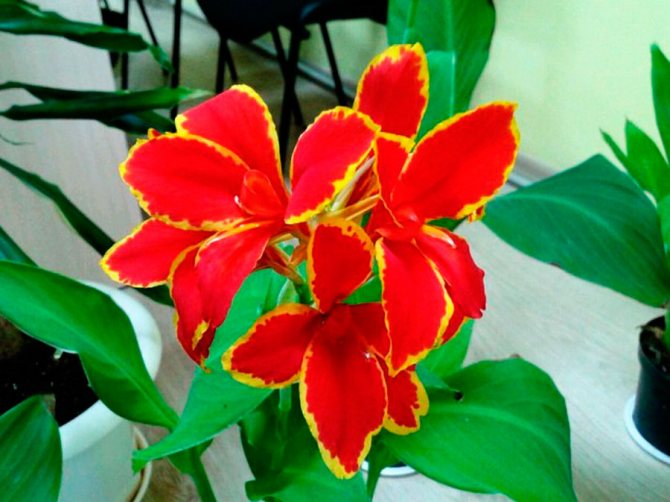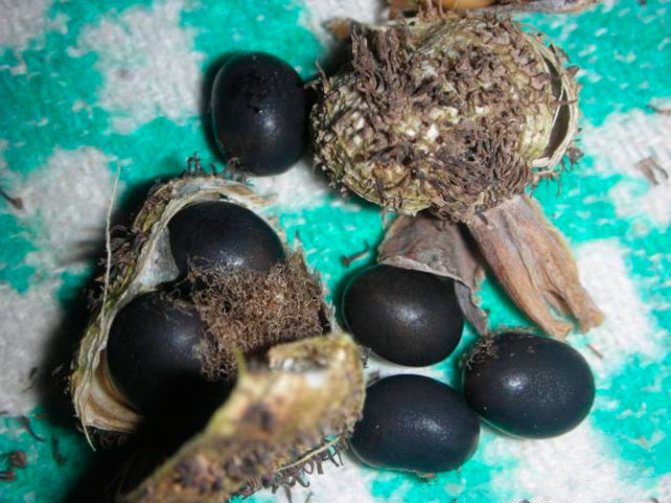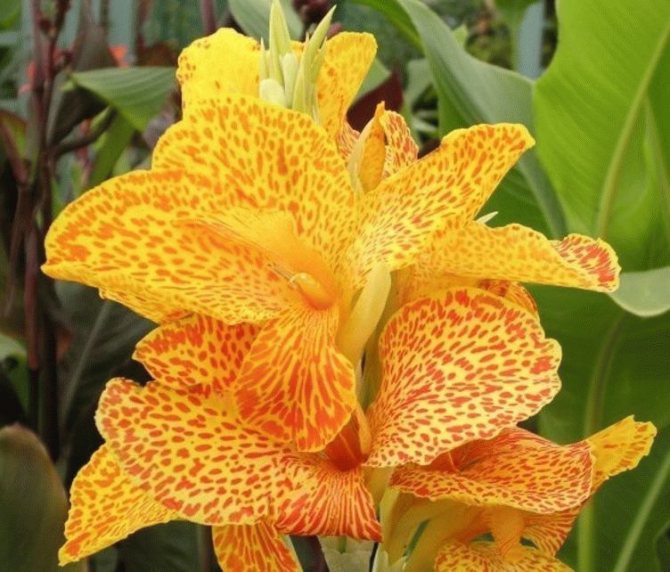Canna is a beautiful perennial flower that has long become a favorite of gardeners and owners of private houses. This flower has a whole host of advantages, which are ease of planting, growing, care and reproduction, as well as a wide variety of varieties. He has only one drawback - the canna does not winter well in the open field. But more on that later. There is an ancient legend that tells of an Indian chief. The old leader burned the peace treaty in the fire, and this entailed a big bloody war. And on the site of that fire, cannes grew, with their bright colors resembling tongues of flame and shed blood.
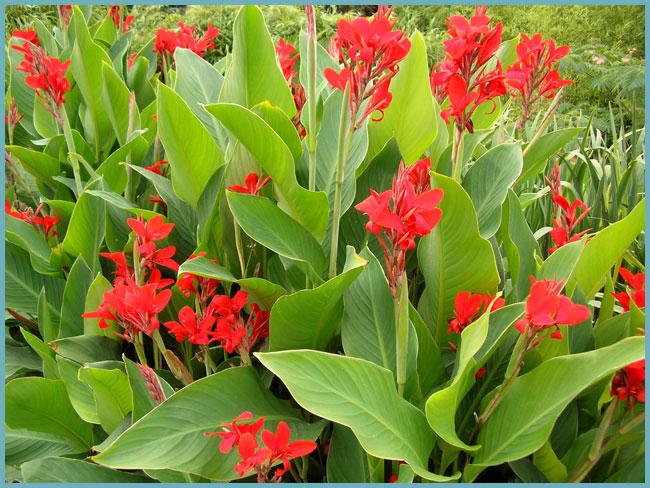
Canna is a favorite flower of many gardeners
Varieties and varieties of cannes
Cannes have a juicy stem, the length of which varies, depending on the species, from 50 cm to 2 m. The first garden hybrid was bred by the Frenchman Crozi. All subsequent cultivated varieties are called "Canna garden" and are divided into three groups.
- Deciduous canna. The highest of the cannes, some varieties reach 3 m. The flowers of deciduous cannes are small, about 6 cm, and the leaves are large with shades from dark green to purple.
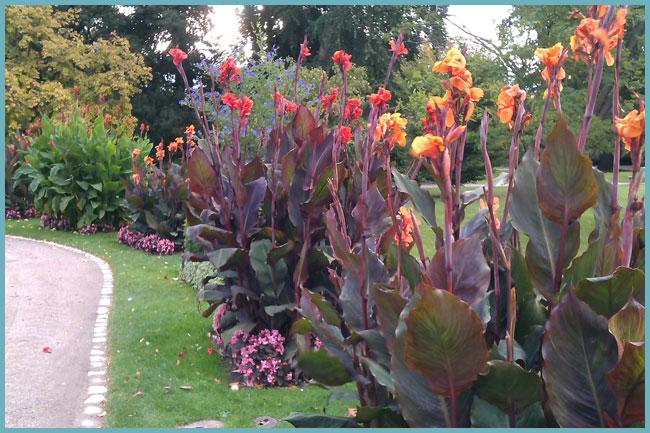

Canna deciduous
- Cannes Crosey. The lowest, their growth is from 70 cm to 1.5 m. The flowers are large, about 10 cm, and the leaves are green or purple with a bluish cover.
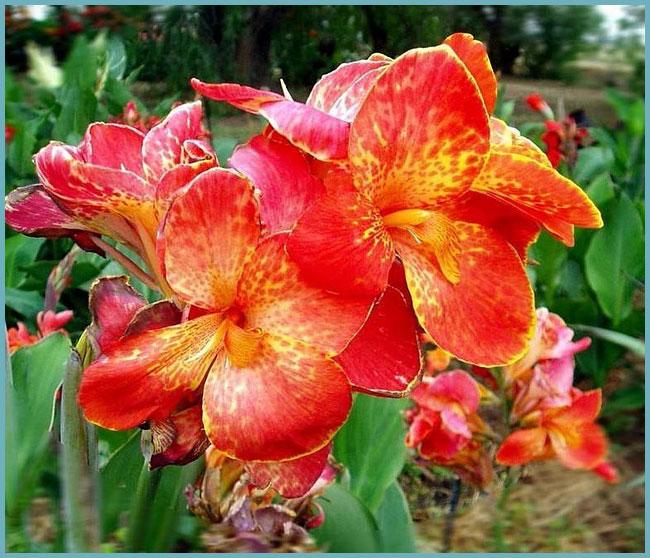

Canna Crosey
- Cannes are orchid-shaped. The group is medium in height, usually up to two meters high, with large, orchid-like flowers and fleshy green leaves with a purple tint.
Popular Cannes varieties
When starting the cultivation of cannes flowers in the garden, you will first have to choose the appropriate specimens. There are about 20 known species found in the wild. Breeders were able to develop and distribute, according to various sources, from 50 to 100 varieties that are successfully cultivated and grown all over the world.
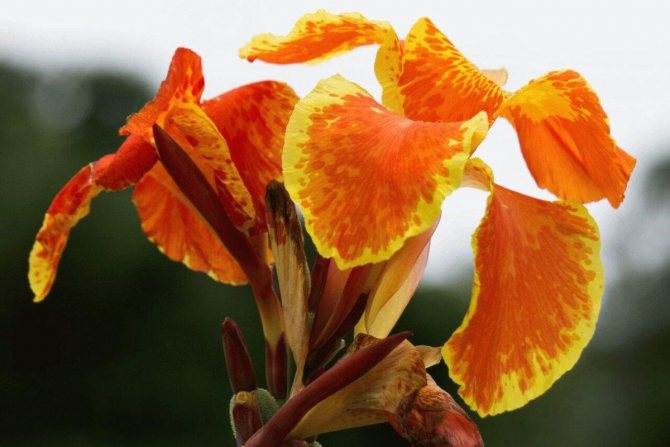

Wild species are:
- Canna flaccida - used as a fragrance released from rich yellow flowers.
- Canna glauca - is widely used in modern horticulture for the development of new varieties, due to its unique shape and frost resistance.
- Canna indica - cultivated because of the branched inflorescence and early flowering period.
- Canna iridiflora - has an average resistance to cold, large buds that bloom almost all summer.
- Canna liliiflora - has a bright, rich floral aroma, white flowers, frost-resistant.
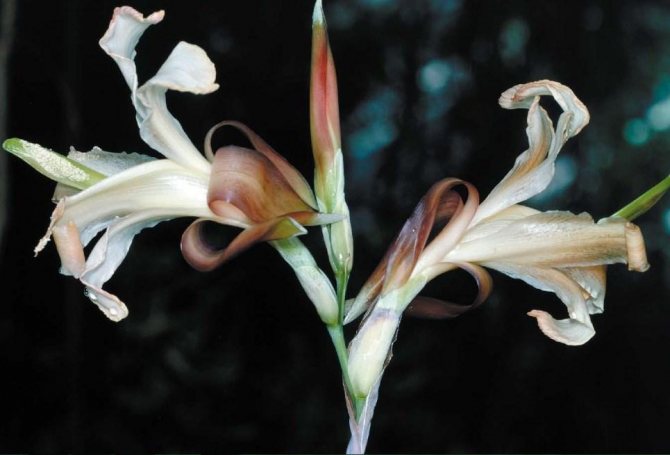

As well as: Canna Paniculata, Canna pedunculata, Canna tuerckheimii, Canna bangii, Canna Jaegeriana. The most popular varieties of cannes already cultivated are:
Tropical canna
Tropical canna (Canna Tropicanna) is the most popular variety, reaching a height of 1.8-2 meters. The flowers are iridescent and very bright, a tangerine shade on the verge of red, exotic bronze foliage. Grown in large quantities for commercial purposes or in personal plots as a hedge.
Canna Los Angeles
The medium-sized gem is a rich, deep pink Los Angeles, which has a large bud that, when fully expanded, vaguely resembles human facial features.
Cannes "Picasso"
A dwarf variety of canna flower, which does not exceed 1 meter in height, which allows you to grow the plant at home.
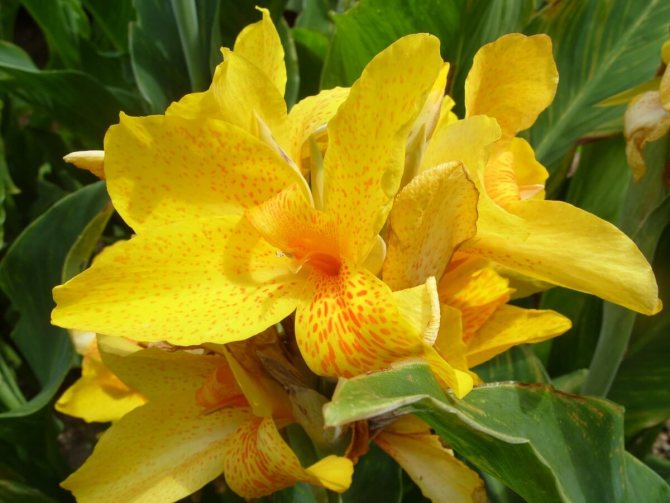

"Picasso" has bright yellow flowers with special dark red blotches, which are also called leopard spots. Blooms from late July to late autumn.
Canna Wyoming
Another variety that can be classified as dwarf or medium. The leaves of "Wyoming" are a rich maroon hue, flowers with lush orange buds. It begins to bloom from mid-summer until the first frost.... Photos of cannes flowers are presented below.


Canna "Musifolia"
"Musifolia" refers not just to large varieties, but to gigantic ones. The size of this flower can reach 2.5 meters in height. The curved leaves are shaped like a banana or boomerang. The flowers are bright orange on the verge of red.
Canna "Apricot Dream"
"Apricot Dream" (Abricot Dream Canna) is from Arkansas (USA). Strong, compact plants no more than 1 meter in height boast attractive gray-green foliage topped with a huge number of bright orange flowers with a pink neck.
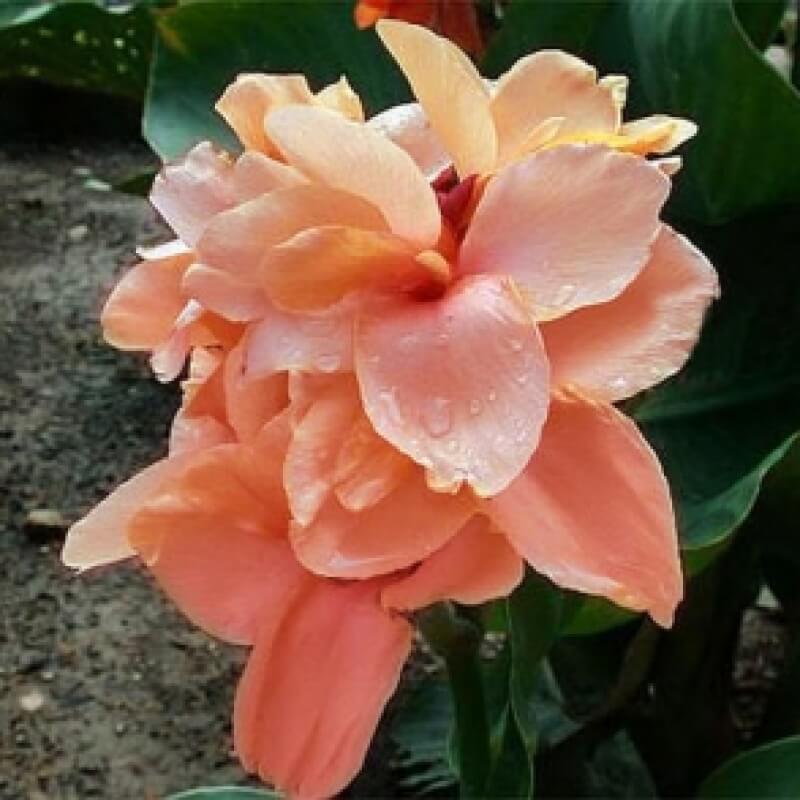

Cannes landing
To plant cannes, choose a place protected from the winds, which is also bright and sunny enough. Cannes prefer deeply cultivated, loose and nutritious soil. The most suitable mixture for them: 1/3 coarse sand, 1/3 leaf earth, 1/3 peat. Cannes are planted in open ground after the end of the frost.
Some gardeners advise making "hot bedding" to make the cannes bloom more lush. To do this, 20 cm of horse manure is first poured into a hole dug about 70 cm deep, and earth is poured on top. Thus, under the layer of the earth, slow burning of manure will occur and generate heat, contributing to a longer and more luxuriant flowering of cannes.
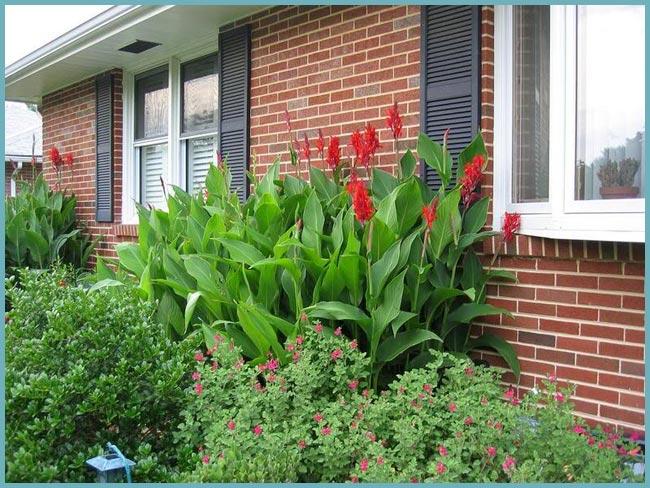

Canna will feel good if you plant it against a wall that protects from the wind.
Cannes seeds need to be prepared before planting. To do this, they are first scalded with boiling water, and then placed in a thermos with warm water for 3-4 hours. Seeds are sown in the greenhouse in February. The temperature in the greenhouse should be 20-23 ° C. Sprouted crops are planted in pots after 2-4 weeks, and when leaves appear, cannes are planted in open ground.
But most often cannes are planted by dividing the root system in late spring or early summer. The roots are planted in holes dug at a distance of 50 cm from each other and fertilized with humus. Sprouted roots are planted to a depth of 10–15 cm, and not sprouted by 5–7 cm. The holes are constantly watered.
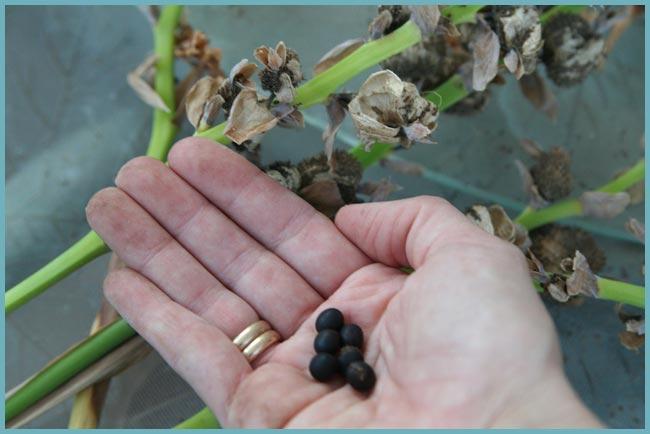

Canna seeds
How to store cannes in winter
When to dig a cannu
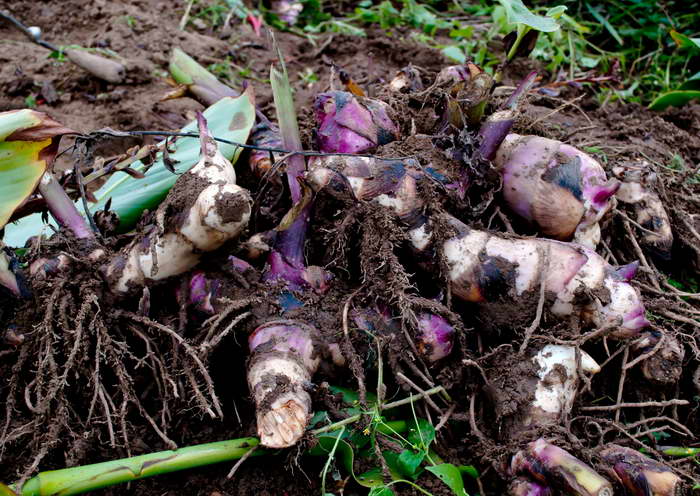

When to dig up cannes and how to store in winter
How to save Cannes for the winter? Cannes are usually dug up in late September or early October and transferred to storage until spring. Best stored in a cool place with ambient light and moderate humidity. Fold the rhizomes into boxes, sprinkle with sand, peat and non-coniferous sawdust. The moisture content of the soil should be about 50%, and the temperature around + 6-8 ° C. Inspect the cannes rhizomes regularly for decay. If you find a tuber infected with rot, cut it to a healthy area, be sure to treat the cut with iodine. Protect tubers from extreme temperature changes.
Cannes in winter in an apartment
If there is no special room, you can store the tubers in the refrigerator. Dig up the roots in the fall, rinse under running water from the ground, hold for 24 hours in a disinfectant solution of manganese (very weak, pink), dry well, wrap each tuber in paper and put in a container designed for storing vegetables. Also check periodically for rot.
You can store dried cannes roots on the balcony: place them in a plastic bucket and sprinkle with dry earth. In severe frosts, you need to bring a bucket into the apartment, the tubers should be laid out under the balcony door on the floor.
The rhizome can still be stored in the potting soil, keeping the temperature up to 15 ºC. You can put the pot on the veranda, attic or glazed loggia. Moisten the soil a couple of times a month. In warm regions without frosty winters, you can dig up the rhizomes of the cannes and store them on the site, avoiding flooding with water and protecting them from the wind. Cover the tubers with dry sawdust in a layer of 20 cm.
Plant care
Cannes are gratefully taken for good care, like any other plant.In order for cannes to bloom on time and look spectacular, they need to get rid of weeds in a timely manner, loosen the soil around the bushes. During the entire flowering period, it is necessary to remove dried inflorescences.
Watering the cannes before the flowers appear should be moderate, but during flowering this flower requires abundant watering. Closer to autumn, watering should be reduced and finally stopped after the cannes have faded. Cannes delight the eye with their bright colors from August to mid-autumn. After that, the roots of the plants need to be insulated with dense hilling in case of sudden frosts. For the winter, the roots are dug up together with a lump of earth around the root and stored in boxes until spring.
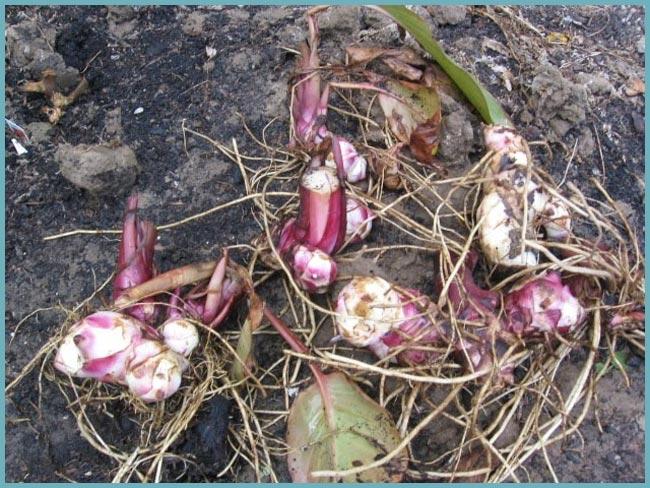

Canna root system
Some growers grow cannes in pots and keep them indoors in the winter, and in the spring they are planted in open ground. This flower is absolutely not afraid of transplanting, and if the frost is already close, and the cannes continue to bloom actively, transplant them into a pot. These beautiful flowers will delight you until December.
Cannes planting in the garden
Fertilizing and watering cannes
Cannes during the growing season should be fed with full mineral fertilizer at least three times. After watering, loosening is carried out. In dry periods, cannes are watered 2-3 times a week. Rhizomes will ripen better if at the end of summer you start to reduce watering, and stop completely before digging.
Cannes garden bloom
The first inflorescences will appear 1.5-2 months after planting. It is best to cut these buds to allow the root system to develop well and grow strong, healthy roots. Removing dead flowers in time, before the formation of fruits, will help maintain the decorative effect of the plant and maintain strength for further flowering. Cannes bloom lasts until frost.
Plant propagation
The simplest and most effective method of propagating these flowers is by dividing the root. To do this, in the spring, at the end of March - early April, the rhizome is taken out of the clod of earth in which it was stored all winter, cleaned of decayed areas and divided into kidneys. Places of cuts are disinfected by sprinkling with coals or ash.
Advice. If two kidneys are close, leave both.
Delenki are planted in boxes with earth or in pots in a greenhouse with a temperature of 20-24 ° C. When the culture sprouts, the temperature is lowered to 16 ° C. For rooting, the delenka can be watered with a 2% solution of potassium permanganate every 10 days.
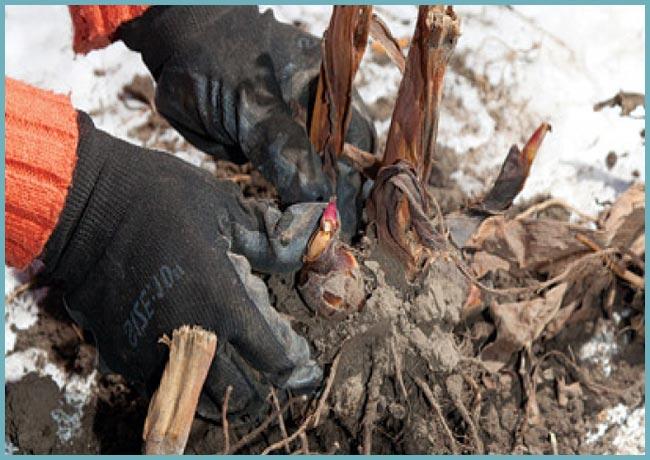

Dividing the cannes bush
Cannes propagation by dividing rhizomes
In March, you need to divide the overwintered rhizome. As a result, each fragment obtained should have 1 large stem bud or 2-3 small ones. The sections of the cut should be treated with charcoal and slightly dried.
Then the rhizomes can be left for storage at room conditions or germination can begin. The second method helps to speed up flowering by 1-2 months. In this case, the rhizomes must be placed in ordinary sand and sprinkled to the level of the buds. They should fit fairly tightly.
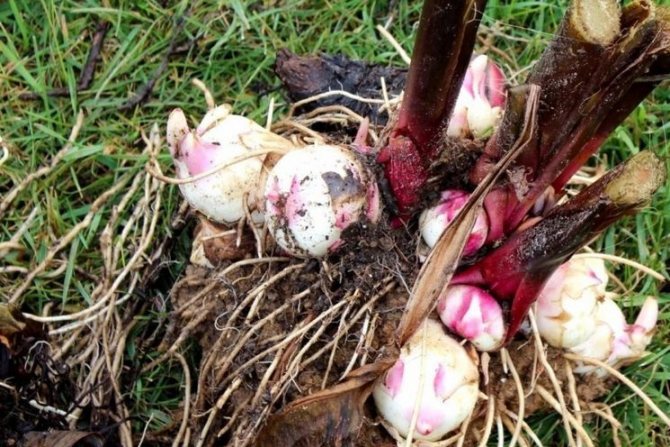

Cannes are propagated by dividing rhizomes
During germination, the sand should be moistened all the time and the temperature should be maintained at 20-24 ° C. Sometimes there is a need to heat the container from below. To speed up the process, you can cover the drawer with plastic wrap. It should be removed 1-2 times a day for 30 minutes. This is done for airing and watering the planting material.
When the first green shoots appear, the film should be removed and each bush should be moved to a separate container. Ordinary sand is perfect as a soil. Germination of rhizomes in individual pots is carried out at a temperature of 16 ° C. This will help strengthen the bushes before planting them in the ground.
Diseases and pests of cannes
Cannes are susceptible to bacterial diseases. They appear on the leaves and buds. The leaves are first covered with white spots, which later turn black. Cannes buds immediately turn black and die. Cannes bacteriosis, unfortunately, cannot be cured.And so that the disease does not spread to neighboring plants, the affected bushes must be destroyed. Bacteriosis is associated with waterlogging.
Also, these flowers can be attacked by rust fungus. It can be seen by yellowed or rusty-stained leaves. The fungus is treated with a solution of 4 g of potassium permanganate, diluted in 10 liters of water.
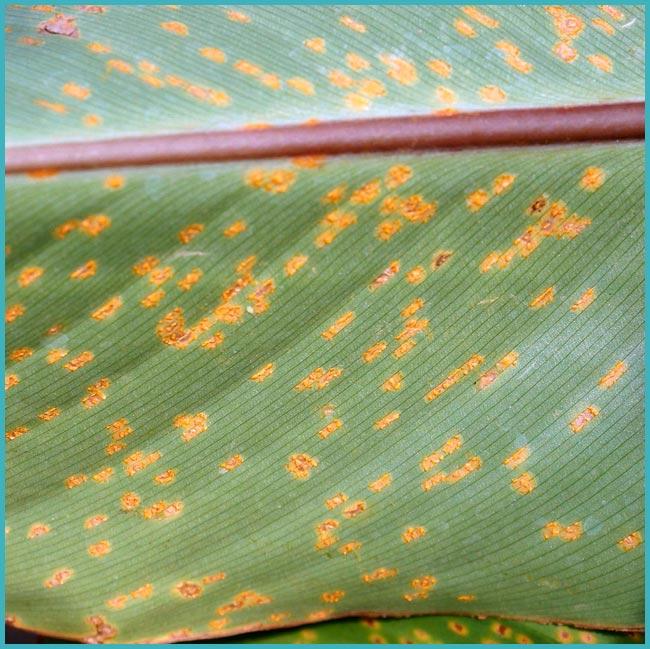

Rust fungus on canna leaves
Very rarely, but still attacks cannes and variegated virus. With this disease, the leaves of the plant are covered with black dots. If the leaves are not removed in time, the virus spreads to the flowers, which decrease in size and curl. When fighting this disease, it is necessary to remove leaves and inflorescences affected by the virus in time.
Cannes leaves can be harmed by caterpillars. In this case, an insecticide helps.
Flowers are not insured against eating roots by nematodes. It is also necessary to get rid of damaged plants.
Canna: combination with other plants
Growing canna along with other plants in a flower bed will not bring you any trouble, because this flower gets along well with its neighbors. The main rule is to take into account the growth rate of flowers planted in the same bed so that the faster growing ones do not drown out their slow neighbors. It will greatly facilitate the care of such a flower bed and the selection of plants with the same requirements for soil and frequency of watering.
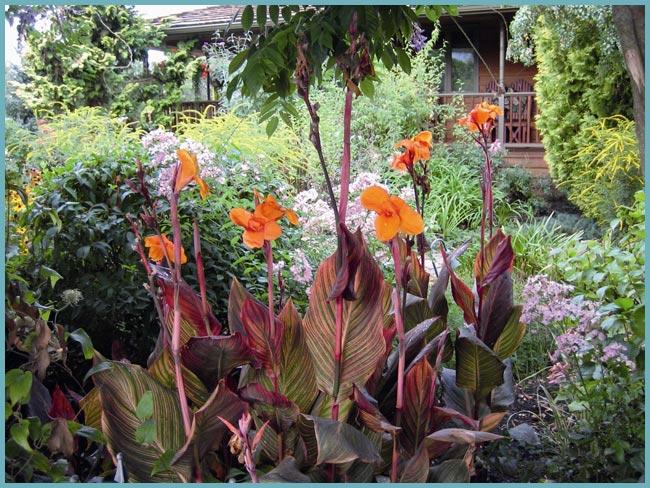

Canna on the flowerbed Council. With the colors of Cannes, you can know the weather forecast in advance. This tropical plant is used to getting rid of excess moisture by releasing it on the leaves. Therefore, when in the morning you see drops of water on the leaves, take an umbrella with you, because the probability of precipitation is very high.
Choosing a place on the site
Like most tropical cultures, Cannes love warmth and light. In order for flowers to please with bright petals, you need to carefully choose a place for the flower bed. It must meet several conditions:
- Lighting. The flower needs a lot of sun. If you plant the plants in the shade, you can not wait for lush inflorescences. The sun's rays should hit the cannes bushes for at least 6 hours a day.
- Wind protection. It is better to plant a crop in a place where it will be protected from strong winds and drafts. The best option is to place bushes on the south side of the house, a monolithic fence or other tall perennials.
- The soil. To maintain an attractive appearance of the canna, a lot of moisture and minerals are needed, so the flower should be planted in fertile soil rich in humus and trace elements. The optimal composition of the soil mixture: garden soil, peat and humus in a ratio of 1: 1: 1. To improve the nutritional composition, experienced summer residents recommend adding ash and rotted manure.
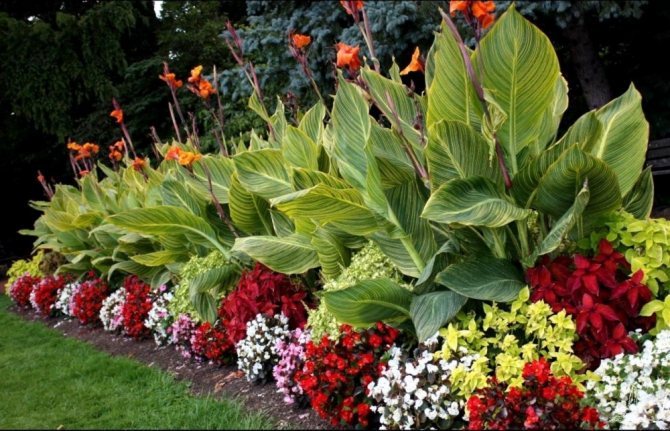

Combining Cannes with other cultures
Advice! Many amateur flower growers plant cannes in deep pots and tubs, decorate terraces, balconies and interiors with them where there is enough sunlight. The rules for planting and caring for potted and garden specimens are the same.
Canna in landscape design
One can talk a lot about the use of canna in landscape design. There is no such place in the flower garden in which the canna would not bring color and contrast. Cannu is often used as a pot and tub plant to decorate interiors, balconies and terraces.
Canna also creates an unforgettable impression against the background of a bright green lawn. High varieties of cannes are suitable for use as a hedge. The lower species in landscaping are planted as curbs, just like lavender.
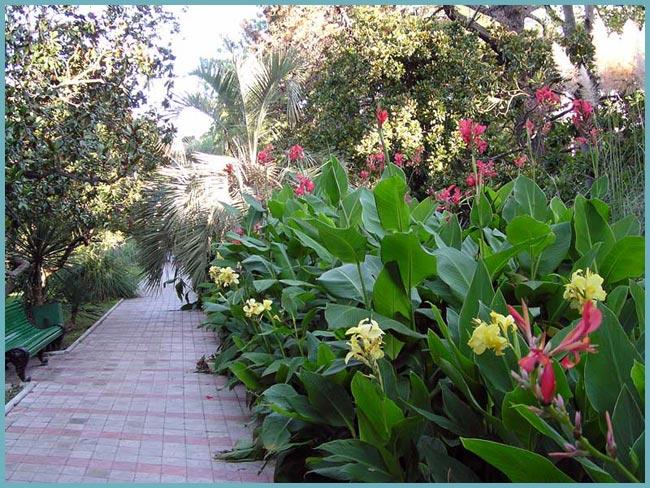

Cannes landing along the paths in the garden
With the right choice of height and grade, cannes can be used anywhere. Massive varieties of these colors allow you to mask not the most aesthetic parts of your site.
Indian canna naturally grows along water bodies, so this species can be planted not only along the pond, but also directly in the water body itself. To do this, the flower is placed in a large basket or flowerpot and placed in a pond so that the surface of the pot is slightly covered with water.
Bright photos of your winter garden and flower garden will not leave anyone indifferent.
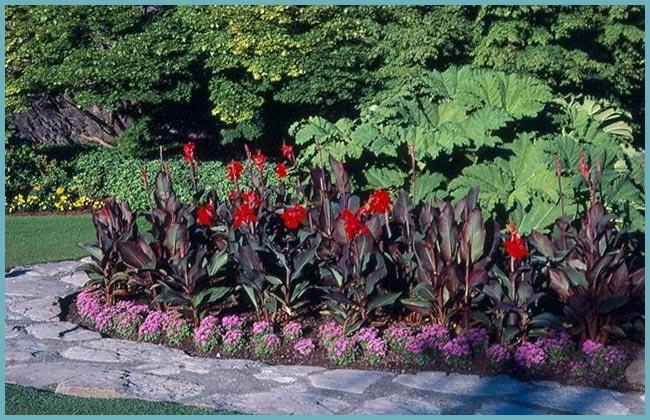

Canna in landscape design
This flower looks no less wonderful in cut. It costs from 4 to 8 days, and is effective both in a mono bouquet and in combination with other flowers.
Gardeners argue that the minor troubles that canna cultivation, reproduction and care entail, are forgotten as soon as this beauty begins to bloom. These bright flowers will delight you until late autumn, bringing a bright variety to the gray autumn landscape. And when your neighbors choose such ordinary yellow leaves for photos, your background will be much more attractive.
Home canna: how to care for a flower at home
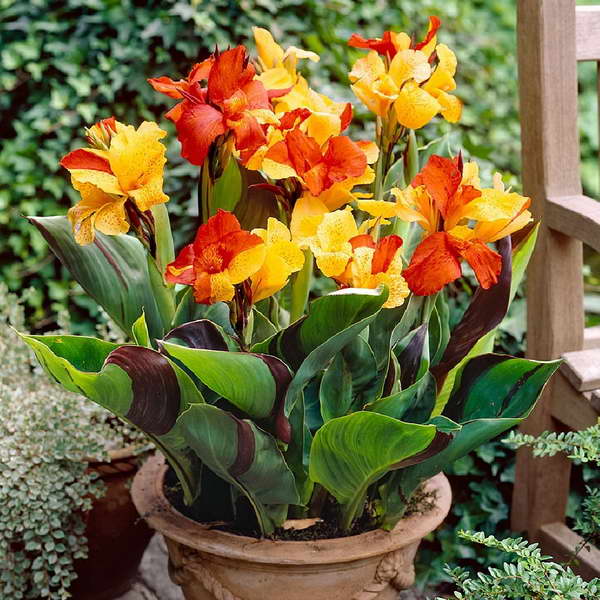

Ampel canna Cleopatra Cleopatra photo
Cannu can be successfully grown in pots or tubs. This applies to species and varieties that can fit in a house, apartment, balcony or terrace. Due to its decorativeness, the indoor canna will become a real center of the flower arrangement of your winter garden. For a home canne, a dormant period of two months is enough, and the rest of the time it will delight you with gorgeous foliage and bright flowering.
Care and proper watering
Cannu is grown at home like any other houseplant. In the fall, you can dig a garden canna, the soil around the plant should first be watered with an insecticide in order to destroy insects and not bring them into the house, transplant the canna into a pot or tub with a diameter of 0.5 m.
It is easier to care for a canna at home than in gardens. There is no need to spray, control weeds, feed and loosen the soil. Give it a place with good lighting, water it with softened, settled water as needed, occasionally wipe the leaves with a damp soft cloth or sponge. After flowering, the leaves will remain bright and delight with beauty.
Dormant period
When the home canna needs rest - after flowering - gradually reduce watering until it stops. Cut the leaves at a height of 10-15 cm from the root, transfer the pot to a cool dry place, the temperature should be at least 10 ° C.
In the spring, the rhizome is removed from the pot, the tubers are divided and planted. You can plant them in pots or in the garden.

